Mediasonic Probox 8-bay 3.5" USB 3.0 / eSATA DAS Review
by Ganesh T S on August 4, 2012 7:55 AM ESTPerformance Benchmarks:
In order to evaluate the performance of the enclosure, we used SSDs under the impression that they would deliver better performance compared to HDDs. We mentioned initially that the Probox doesn't support 2.5" drives. However, with careful manual handling, 2.5" SSDs could be connected to the internal ports with the unit laid sideways (to avoid the SSDs hanging off the internal SATA connectors).
The following IOMeter benchmarks were run in both eSATA and USB3 mode for configurations involving disks in 1, 2, 4 and 8 bays.:
- 128K Sequential Accesses with a queue depth of 1
- 4K Random Accesses with a queue depth of 3
- 4K Random Writes with a queue depth of 32
Despite my intent to benchmark all possible configurations for both eSATA and USB3, I found that the P8H77-M Pro's eSATA port would BSOD frequently whenever we had more than 2 drives being accessed using its port multiplier feature. Any missing bars in the above graph indicate that the test couldn't complete because of this issue. In fact, Mediasonic strongly recommends PCI-E add-on cards with Silicon Image 3132 / 3124 chipsets which have support for FIS based switching with port multiplier.
In addition to the above benchmarks, we also ran the DiskBench tests that we use in the NAS reviews. The graphs below present the results obtained in the four tests.
One of the main issues I found with SSDs was the increase in I/O response time when multiple disks were being simultaneously accessed through IOMeter. I found this mainly during access through USB 3.0. The issue may be present even in the eSATA configuration, but I am unable to confirm it due to the port multiplier issue.
In the configurations under which eSATA worked, it seems to have a steady increase in performance as more disks are accessed. Through USB 3.0, however, the performance seemed to plateau very soon. Was this something specific to SSDs or would it manifest itself even with HDDs? The next section tries to analyze this further.


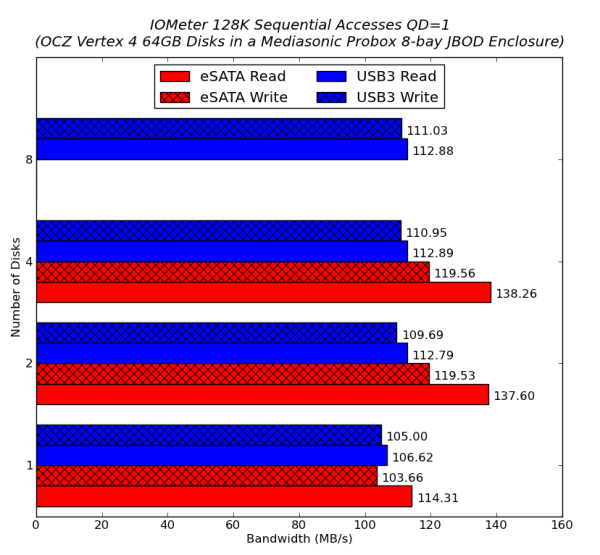
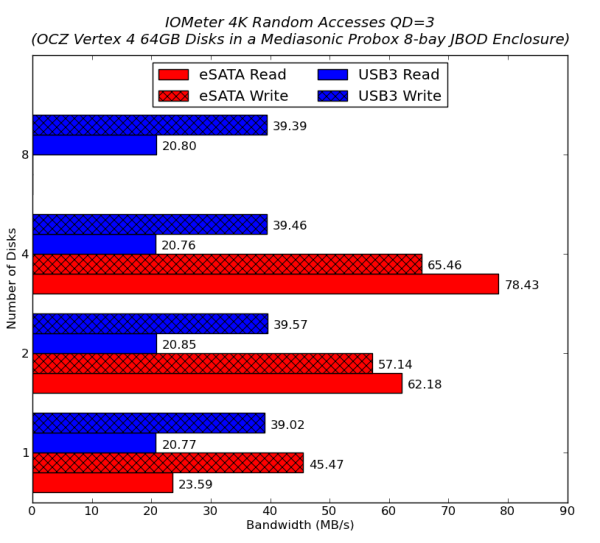
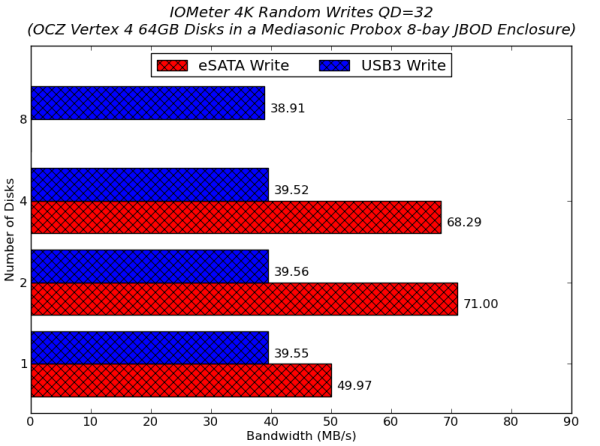
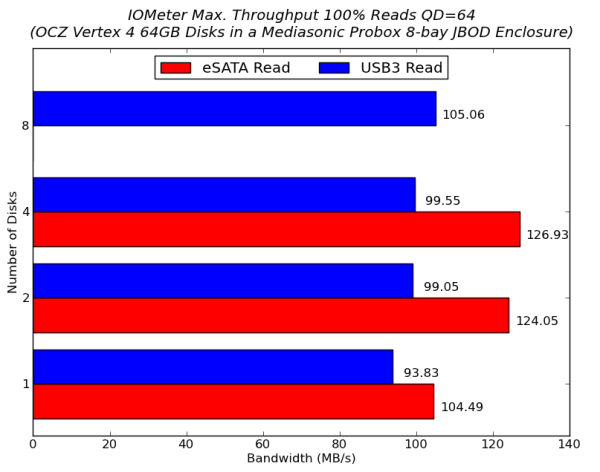

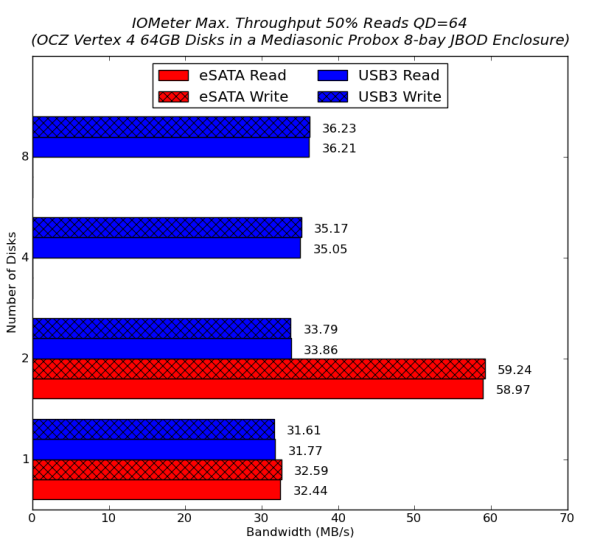
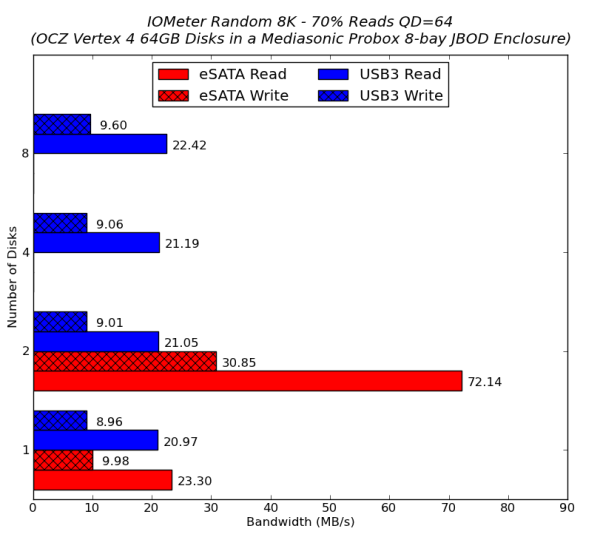








48 Comments
View All Comments
repoman27 - Saturday, August 4, 2012 - link
When you guys review USB 3.0 gear, you really need to address whose drivers you are using on the testbed and whether the device is operating in BOT, BOT with oversized payloads, or UASP mode.USB without UASP doesn't support queuing, so increasing the queue depths won't make much difference in your results. I'm guessing you were operating in BOT mode with default payload size and that is why eSATA was able to outperform USB 3.0. (And looking at the specs for the JMS539, I don't see any mention of UASP support.)
repoman27 - Saturday, August 4, 2012 - link
Also, most reviews don't mention specifically which USB 3.0 controller is being used, although in this case the board in question only has the integrated Intel controller.In the interview with JJ from Asus, he mentioned that memory bandwidth had an impact on Intel integrated USB 3.0 performance. I'm not sure if you have ever seen this borne out in actual testing, but I did note that your testbed was only running DDR3 1333.
ganeshts - Saturday, August 4, 2012 - link
I should have specified this in this review too. But, over here [ http://www.anandtech.com/show/6014/startechcom-usb... ], using the same testbed, we found that UASP is not supported by the Intel PCH's USB3 ports. Only ASMedia supports it right now.Further, the JMicron USB3 - SATA bridge supports only BOT specifications, as you have indicated. So, UASP enabled testbeds would probably have not made any difference.
repoman27 - Monday, August 6, 2012 - link
Supposedly some Asus boards will support UASP on the USB 3.0 ports provided by the Intel PCH using the Asus drivers. [ http://www.tomshardware.com/reviews/usb-3-uas-turb... ] I believe UASP is also supported for the integrated Intel USB 3.0 controller under Windows 8 and Mac OS X.Even using BOT though, increasing the maximum transfer length can have a considerable impact on sequential performance. So I wonder if your numbers are at the upper end for the Probox, or if it still had another 20-25% to go under USB 3.0 given the right conditions.
At this juncture, directly comparing benchmarks of USB 3.0 storage solutions is a total crap-shoot because there are so many variables and almost every site reviewing gear glosses over a fair number of the details.
yyrkoon - Saturday, August 4, 2012 - link
Ok I have not finished reading the article yet, but I *have* to say something.What do you mean there were no such issues with USB 3.0 in relation to your eSATA port multiplication issues ? This makes you the reviewer sound clueless. PM support always depended on very few specific Intel, Jmicron, and now I suppose Marvell chip sets to work..
Just to clarify This is a failing in your motherboard(s) or discrete eSATA controller cards. Not the fault of the enclosure. .
yyrkoon - Saturday, August 4, 2012 - link
Sorry, I said Intel Chip sets, where I meant Silicon image chip sets. Silicon image 3114, and 3132 chip sets where provided on a very few motherboards back in the Core2Duo days. A few generations of motherboards before ABIT dropped out of the motherboard business.At any rate. Addonics has made/sold PM capable controller cards for years.
ganeshts - Saturday, August 4, 2012 - link
When I specificed 'USB 3.0 had no such issues', I meant that I was able to access all the drives in the enclosure without experiencing BSODs unlike the eSATA case. I think all our readers know enough to understand that USB 3.0 has no port multiplication feature :)Yes, I have mentioned that it is a problem of the eSATA ports of most systems out there, and I have also mentioned that Mediasonic should have bundled one of those eSATA cards capable of seeing 8 drives through the eSATA port. Otherwise, they end up with customer service threads like the one here : http://forum.mediasonic.ca/viewtopic.php?f=27&...
yyrkoon - Saturday, August 4, 2012 - link
"I think all our readers know enough to understand that USB 3.0 has no port multiplication feature :)"This is not what I was saying. My point was that technically, the eSATA issues you had, was all the fault of the hardware you used to connect to the tower. E.G. your motherboards. But it looked like you were saying that Mediasonic's eSATA implementation was bad. Which is very likely not the case. No use in lamenting over a controller card not being included. As when you purchase such a device. You had better know what you're getting into, and you should already know this.
This is the problem with multiple drive eSATA technology. It is complicated, convoluted, and in general half baked from conception compared to other technologies. However, do not get me wrong, I personally was very interested in eSATA PM technology from the start 5+ years ago. From specification to end user product however. It rarely pans out very well. Unless you spend boatloads of cash. Where you have to ask yourself "why eSATA instead of SAS, or ( insert other external drive technology here )..
With everything above said. I think that manufactures should just leave eSATA out of the mix, and pass the savings onto us. the consumers. USB3 is not great, but it is good enough and flexible. Thunderbolt I think could be a great option too. If someone were to make say a 4 SATA drive to Thunderbolt bridge device.
As for the "bad customer service thread thing". I think you would find that with many, many eSATA implementations. Even the single drives ones. Have many issues. Where drives suddenly drop offline, experience terrible speeds. ETC,ETC. This is why yours truly completely opted out of eSATA entirely, and went with USB3.
tuxRoller - Sunday, August 5, 2012 - link
I interpreted the author as saying that the problem lay in the side of the motherboard companies making it too difficult to determine if their esata chip is multi-port aware.yyrkoon - Sunday, August 5, 2012 - link
Yeah I got that. However, I like you recognized the authors um . . . obvious inexperience with the given technology.You *do not* go out and test equipment like this without having the proper support hardware as well. Complaining, whining, or otherwise crying about hardware not included is simply inexcusable.
The things you, and I both know. Is that port multiplier technology does not work without the proper controller chip set period. Sometimes, with the right equipment, you *can* perhaps access RAID arrays previously setup by a system that did have the right controller chip set. However, that array has to have previously been setup with an appropriate SI controller( or equivalent ). It is miraculous that the reviewer was even able to see even a single drive. Let alone all drives one at a time. If I understood what was written correctly. Granted, a few Addonics products can / do this for the user through hardware switches. . .
You know this. I know this. The difference between you and I however. Is that you have actual hands on experience with the hardware / technology. I on the other hand have no hands on experience. Just a lot of reading over the past several years ( since the specification was released ). As eSATA PM technology has always been of interest to me.
The point being here. Is that if someone can have knowledge of something without laying hands on actual hardware. There is no reason why a reviewer ( hopefully someone with some expertise ) should not as well.
@ Ganesh
Take this as a learning experience Ganesh. Not a slight. With a little more preparation, research, then perhaps willingness to work with the given hardware. Us readers could have learned more, and we could have had a proper review of the given product. As it stand, personally I feel like your review is incomplete.